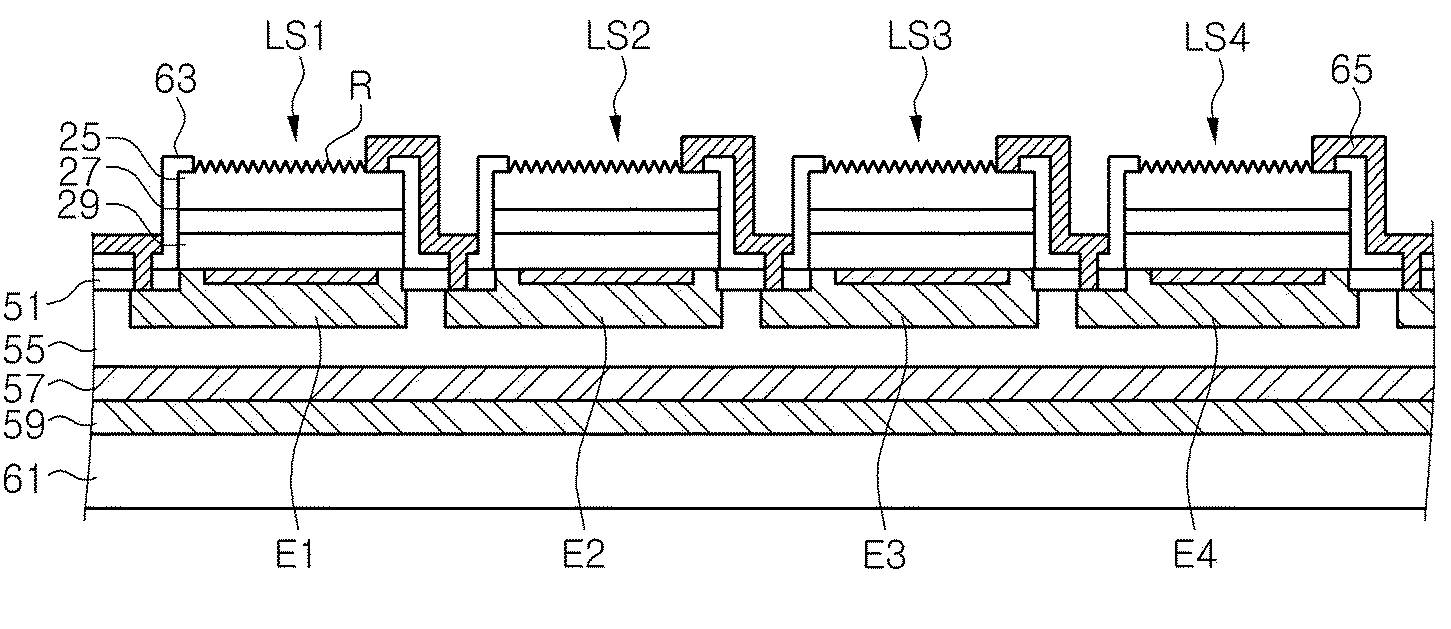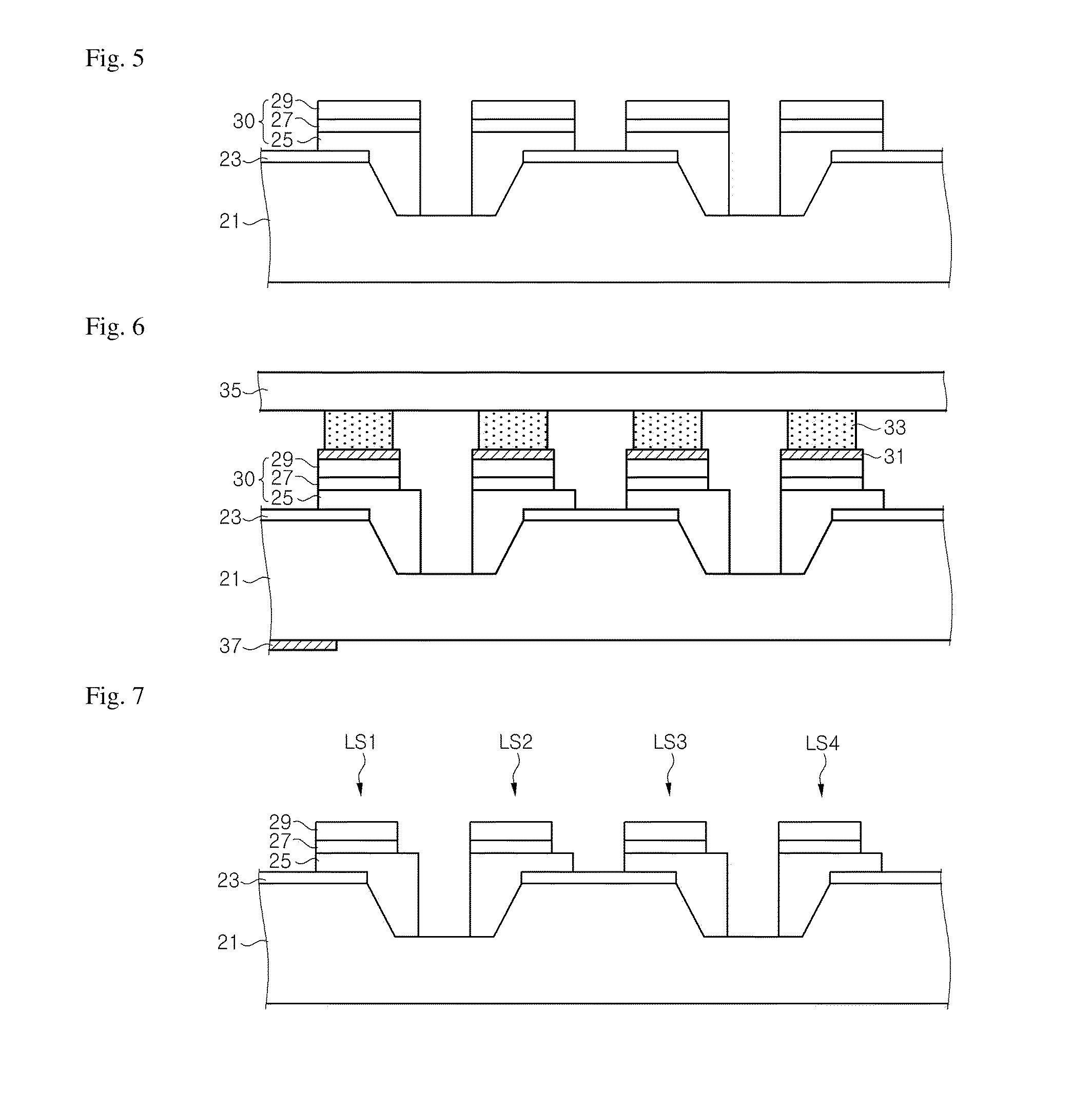Light emitting device having plurality of non-polar light emitting cells and method of fabricating the same
a light emitting cell and non-polar technology, applied in the direction of semiconductor/solid-state device manufacturing, semiconductor devices, electrical devices, etc., can solve the problems of difficult to increase the thickness of a light emitting layer, reduce the luminous power of the light emitting layer, and cost a great deal to grow a nitride semiconductor. , to achieve the effect of excellent crystallinity and saving fabrication costs
- Summary
- Abstract
- Description
- Claims
- Application Information
AI Technical Summary
Benefits of technology
Problems solved by technology
Method used
Image
Examples
first embodiment
[0058]FIG. 6 is a sectional view illustrating a method of fabricating a light emitting device having a plurality of non-polar light emitting cells 30 according to the present invention.
[0059]Referring to FIG. 6, reflective metal layers 31 are formed on the light emitting cells 30, respectively. The reflective metal layer 31 may be formed, for example of Ag or Al. Further, the reflective metal layer 31 may be formed on a portion of the light emitting cell 30, is and a protective metal layer (not shown) may be formed to cover the reflective metal layer 31.
[0060]A second substrate 35 is bonded to the reflective metal layer 31 through bumps 33. The second substrate 35 may be a submount substrate, for example. The second substrate 35 may have an electric circuit therein. The substrate 21 may be a conductive silicon carbide substrate, and an electrode pad 37 may be formed under a lower surface of the substrate 21. Accordingly, there is provided a flip chip having the non-polar light emitt...
second embodiment
[0061]FIG. 7, FIG. 8, FIG. 9, and FIG. 10 are sectional views illustrating a method of fabricating a light emitting device having a plurality of non-polar light emitting cells according to the present invention.
[0062]Referring to FIG. 7, nitride semiconductor layers 25, 27 and 29 are grown on a substrate 21 as described with reference to FIG. 1, FIG. 2, FIG. 3, and FIG. 4. Then, the nitride semiconductor layers 25, 27 and 29 are etched to form light emitting cells LS1, LS2, LS3 and LS4 separated from one another. The first conductive-type nitride semiconductor layer 25 is partially exposed by removing portions of the second conductive-type nitride semiconductor layer 29 and the active layer 27. That is, each of the light emitting cells LS1, LS2, LS3 and LS4 comprises the first conductive-type nitride semiconductor layer 25, the second conductive-type nitride semiconductor layer 29 positioned on one region of the first conductive-type nitride semiconductor layer 25, and the active la...
third embodiment
[0067]FIG. 11 is a sectional view illustrating a method of fabricating a light emitting device having a plurality of non-polar light emitting cells LS1, LS2, LS3 and LS4 according to the present invention.
[0068]Referring to FIG. 11, after the wires 47 of FIG. 10 are formed, an interlayer insulating layer 49 is formed to cover the light emitting cells LS1, LS2, LS3 and LS4. The interlayer insulating layer 49 prevents the light emitting cells LS1, LS2, LS3 and LS4 from being short-circuited. A second substrate 50 is bonded to the interlayer insulating layer 49.
[0069]The second substrate 50 may be a submount substrate, and accordingly, there may be provided a flip-chip light emitting device. The submount substrate may have electrode pads, and pads (not shown) for supplying power to the light emitting cells LS1, LS2, LS3 and LS4 may be electrically connected to the electrode pads on the submount substrate through the interlayer insulating layer 49. In this case, light emitted from the l...
PUM
 Login to View More
Login to View More Abstract
Description
Claims
Application Information
 Login to View More
Login to View More - R&D
- Intellectual Property
- Life Sciences
- Materials
- Tech Scout
- Unparalleled Data Quality
- Higher Quality Content
- 60% Fewer Hallucinations
Browse by: Latest US Patents, China's latest patents, Technical Efficacy Thesaurus, Application Domain, Technology Topic, Popular Technical Reports.
© 2025 PatSnap. All rights reserved.Legal|Privacy policy|Modern Slavery Act Transparency Statement|Sitemap|About US| Contact US: help@patsnap.com



